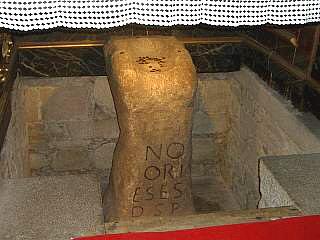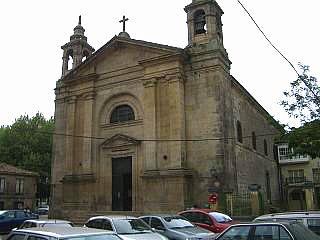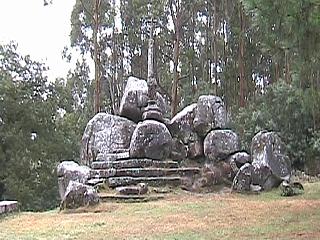Padron's monuments
The Pedron, Church of Santiago and "Santiaguino del Monte"
The Pedron
The Pedron is a large and ancient stone that Galician history claims the boat carrying the body of Saint James was moored up to. Today you can see the Pedron in Padron's church of Santiago.
 The Pedron is sited directly under the church's alter and is illuminated by lights above it. The position it occupies is said to be exactly as it was at the time of the boats visit and you can walk within feet of the stone and examine it. You can also photograph and video the Pedron.
The Pedron is sited directly under the church's alter and is illuminated by lights above it. The position it occupies is said to be exactly as it was at the time of the boats visit and you can walk within feet of the stone and examine it. You can also photograph and video the Pedron.
Unfortunately, recent investigations suggest that the Pedron was in fact an early Roman alter stone (possibly used in the original church of Santiago) and not the artifact that many would like to think, but there is evidence on both sides. In any event, the stone was actively used for some Christian purpose up to 2000 years ago and can clearly lay claim to its heritage as a religious artifact.
The church of Santiago
The church of Santiago's main claim to fame is its housing of the Pedron,
 but there has been a church on this site since 1133 AD and the foundations still contain an inscription dating back to these times.
but there has been a church on this site since 1133 AD and the foundations still contain an inscription dating back to these times.
Right the front of Padrons famous church of Santiago that house's the "Pedron" stone.
The church that occupies this spot today is however from a later time and was founded by "Rodrigo de Luna y Alonso 2nd" in the fifteenth century. The alter of the church is dedicated to Neptune and the external façade is large and imposing.
Santiaguino Mount ("Santiaguino del Monte")
Also known as San Gregorio's mount, this historic spot was said to be the preaching ground of Saint James whilst he was in Galicia.
 Today it is a collection of stones and boulders with a stone cross at its head and you can reach the summit by climbing a handful of heavily warn steps. This is also the point at which pilgrims on the road to Santiago must pass through " hell, purgatory and glory" if they are to satisfy the Camino trail.
Today it is a collection of stones and boulders with a stone cross at its head and you can reach the summit by climbing a handful of heavily warn steps. This is also the point at which pilgrims on the road to Santiago must pass through " hell, purgatory and glory" if they are to satisfy the Camino trail.
There is also a small church at the site as well as a fountain, that St.James is said to have caused to gush water when he thrust his staff into solid stone, as a demonstration of God's power.
Above the collection of stones is a large picnic style area where pilgrims (and anyone else) can rest up and take some refreshment.
Santiaguino mount is an important stop off point for pilgrims doing the "Way of Saint James" (Camino) and on reaching the mount they must pass through three separations in the rocky formation known as Hell, Purgatory and Glory in order to meet the Camino's requirements. Only by doing this can they claim the "Jubilee" at the end of their journey.

To the right, the fountain at Santiaguino mount where the apostle is reputed to have dashed his staff in to the ground and produced water.

